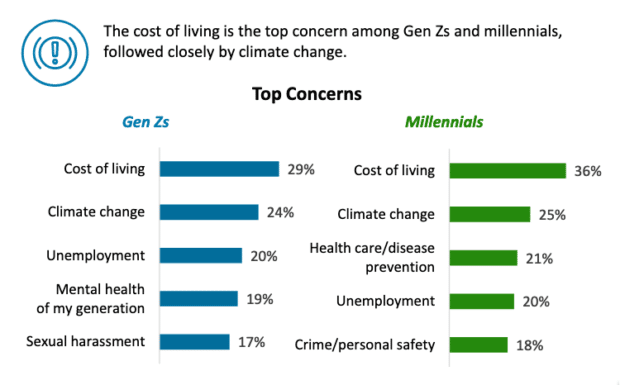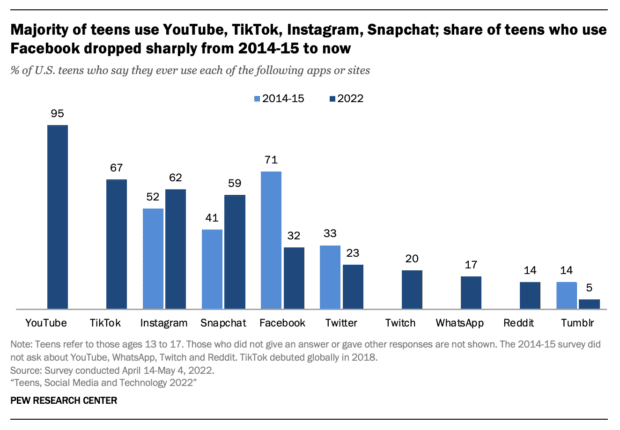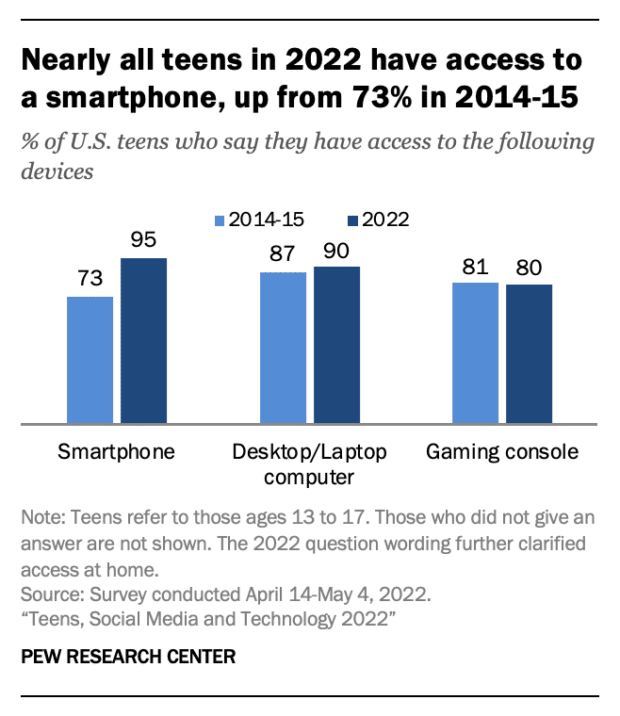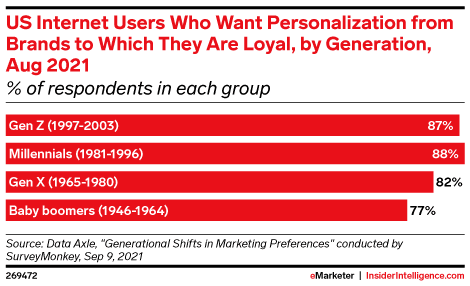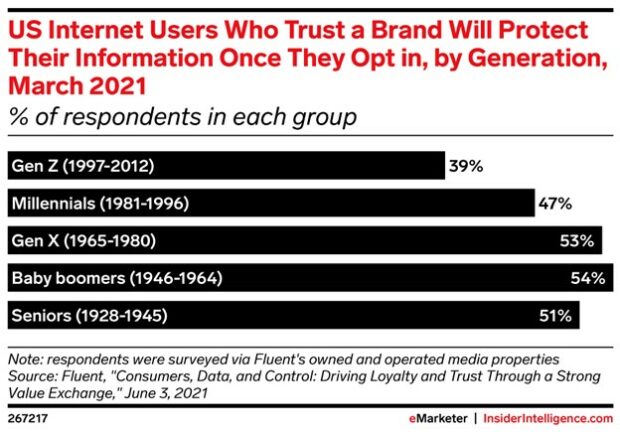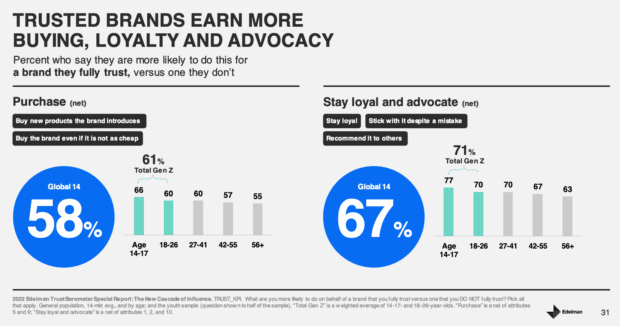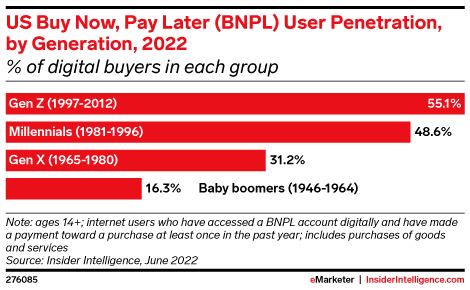A few years ago, the oldest Gen Zers were still in high school. Practically infants. Now, the oldest are 25 and rapidly moving up corporate, and other, ladders.
How do you adjust your marketing strategy to include Gen Z without turning away your existing audience, or worse, looking like you’re trying too hard?
Here’s what you need to know about Gen Z to effectively market to this savvy, smart, and social-first generation.
General Gen Z stats
1. Gen Z is 20.67% of the U.S. population
That’s 68,600,000 Americans.
Some say anyone born in the 1990s is part of Gen Z, though the most widely accepted definition includes those born during or after 1997. Many researchers agree Gen Z ends in 2010, but some argue 2012 is the cutoff for where Gen Z ends and Generation Alpha begins.
2. A majority of Gen Z supports a more inclusive society
While the same number of Gen Zers as Millennials—both 84%—say marriage equality is either a good or neutral thing for society, Gen Z is more likely to say people using gender-neutral pronouns should be more accepted.
59% believe forms and other documents should have more than “man” or “woman” options, and 35% personally know someone using gender-neutral pronouns.
So, don’t jump on “rainbow washing” your next campaign solely for Pride month in the hopes of going viral for your efforts. Show real support for your 2SLGBTQIA+ customers and the community by consistently donating proceeds to charity or taking other meaningful actions.
3. Cost of living is the top concern of almost 1/3 of Gen Z
While cost of living (29%) and climate change (24%) are the top concerns of both Gen Z and Millennials, Gen Z is much more concerned about mental health (19%) and sexual harrassment (17%) than previous generations. Additionally, only 28% of Gen Z think their economic situation will improve within the next year.
This doesn’t mean tune your marketing to the doom and gloom station, but being aware of what your customers are struggling with allows you to offer opportunities for genuine connection.
4. 95% of people ages 13-17 use YouTube
The top three social platforms among younger members of Gen Z are YouTube (95%), TikTok (67%), and Instagram (62%).
While you don’t need to use every platform your audience does just because they do, you should be aware of changing trends. You know what’s perfect for that? Our Social Trends 2025 report, and future updates, where we do that for you.
5. 36% of American teens 13-17 think they spend too much time on social media
Also from the same study: 54% would find it difficult to stop using social media.
The majority of teens who felt that way were ages 15-17, indicating social media use becomes even more ingrained in their daily lives as they get older.
6. 61% prefer short videos under 1 minute long
This study grouped Gen Z and Millennials together, but the findings are clear: Short-form video is the future present.
Longer content isn’t dead, though. The same study found 20% of people watch videos over 30 minutes long, too. The key point is context. Where is Gen Z watching short-form videos? What types of videos are they watching?
Which brings us to…
7. Gen Z spends 24-48 hours per month on TikTok
That’s about 5% of all awake time, using estimates gleaned from research in our Digital Trends 2025 report. While these statistics weren’t isolated to only Gen Z, it’s fair to assume they are spending at least 24 hours per month on TikTok—the most conservative data estimate from the survey.
Other studies have reported the average user spends 48 hours per month on TikTok. That’s two days. Twenty-four days per year. Almost a month! Blimey.
Remember when Twitter had their own short-form video format, Fleets, in 2021? No, you don’t. Lesson learned? TikTok is the short-form king. Get an account and plan your TikTok marketing strategy right now (if you haven’t already).
8. BeReal is currently the top social networking app on the Apple App Store
Never heard of it? You’re not alone. The app launched in 2020 but has recently become popular with Gen Z.
It sends out random notifications that users have two minutes to respond to by making a post in the app. Unlike current platforms where users spend considerable time editing photos and composing eloquent captions, BeReal is all about quick updates. You’re supposed to share what you currently look like via an in-app photo—no filters or photo editing capabilities here—and what you’re doing.
While BeReal isn’t meant for brands, it’s important to recognize when new apps enter the game and evaluate if they fit into your marketing strategy.
9. 83% of Gen Z shops on social media
The pandemic boosted overall consumer comfort with shopping on social media, but Gen Z was leading the charge for social-first experiences well before 2020.
Now with major platforms like Facebook, Instagram, TikTok, and others offering social commerce tools like in-app checkout, it’s time to set up your social shop if you haven’t already.
10. Almost 1/3 unfollow or block brand social media accounts weekly
No pressure on getting that content just right before you post it, though, ‘kay? The reason Gen Zers gave for this in the study was weeding out companies they view as pretending to care, but really only caring about profit. It has nothing to do with a company’s products or quality, only their actions and messaging.
We know you hear it all the time: “Have an authentic brand!” Okay, but what does that mean?
It means be human in your approach to marketing, social media, and customer interactions.
Gen Z and technology statistics
11. 95% of American teens ages 13-17 have a smartphone
That number was only 73% in 2015, a 30% jump in 7 years.
Additionally, 90% have a computer and 80% have a gaming device in their home, which was about the same as 2015’s statistics.
Smartphones are now a way of life and likely to be your first touchpoint with Gen Z.
12. 60% think digital first impressions are more important than in person ones
This is smart thinking considering the social media monitoring capabilities of many Human Resources departments. It also means Gen Z is judging your digital first impression before they ever consider buying from you.
13. 43% of Gen Z remember the last website they visited, but not their partner’s birthday
Only 38% remember their partner’s birthday more often than their last website click. Ouch. Don’t feel bad: 31% remember the website more often than their own Social Security Number, too.
14. 40% of Gen Z use TikTok for search instead of Google
Umm, what? That was my first reaction upon hearing this, as a geriatric 35-year-old. But, it tracks:
As an elder millennial who came of age when Google became a verb, I had difficulty grasping that ~40% of Gen Zers use TikTok for search.
So I hosted a mini-focus group with Gen Zers to learn more.
Here are 3 takeaways:
— Adrienne Sheares (@AdriSheares) August 12, 2022
It’s important to note the 40% figure was a comment made by a Google VP during a speaking event about Google’s products and how search has changed. While it’s not an immediately verifiable number, he said Google has studied this and those were their findings of U.S. users ages 18-24.
So it’s pretty legit. (But what are we going to say now instead of, “Just Google it?” “I’ll Tok that up?” “Let me Tik that for you?” Gross.)
15. 92% of Gen Z multi-task while browsing the internet
This is more than any other generation. Tasks paired with web browsing include eating (59%), listening to music (also 59%), and talking on the phone (45%).
Marketers, assume your Gen Z audience will be at least partially distracted when interacting with your content. Keep headings large, pages skimmable, and get to the point quickly.
16. 85% prefer chat or automated customer service interactions over phone calls
This is a significant difference compared to Boomers, where only 58% use chat or automated tools when they need customer service.
Automated customer service isn’t always about saving money, it can also provide faster, easier results for your customers. Plus, business chatbots can mix automation with real human live chat capabilities for the best of both worlds.
Gen Z online shopping statistics
17. 64% look up a local business’ website before shopping or visiting in-person
This underscores the importance of having a professional brand image online, even if you don’t sell online (and don’t plan to).
Reserve your name on social media platforms and at least upload your logo as the profile picture. Create a website—even a simple one—listing your services, hours, and a way to contact you.
18. 97% say social media is their top method for researching shopping options
Whether scrolling influencer posts, ads, or friends’ content, Gen Z window shops on social first. Your marketing strategy needs to address how you’ll get in front of them on social. Easiest path? Influencer marketing.
19. 87% want a personalized shopping experience
Personalized marketing isn’t new, and in fact, the percentage of shoppers who want customized service from brands has stayed relatively constant since Gen X (1965-1980).
If you aren’t already investing in personalization strategies beyond “Hello, [first-name],” do it.
20. …But only 39% of Gen Z trusts companies to protect private data
Almost highest-ever demand for personalized service with the lowest-ever level of trust for business? Cool, great combo.
Build trust by having security policies to protect customer data from theft, cyber attacks, and other threats. But customers aren’t going to browse your terms and conditions for fun. You need to communicate trust and responsibility within your opt-in and checkout pages.
21. 73% of Gen Z only buy from brands they believe in
There is a significant difference between older and younger Gen Zers. 84% of 14-17 year olds said they make purchase decisions based on value alignment, whereas 64% of 18-26 year olds said the same.
Previous generations didn’t expect private business to be as involved in society. Now, not taking a stand on social issues is taking a stand. However, ensure you take yours authentically, because people can tell when you’re only doin’ it for the views.
22. 71% stay loyal to brands they trust, even if they make a mistake
Trust is important to customers in all generations, but it is paramount to Gen Z. 61% of Gen Z will pay more for brands they trust, and 71% will forgive and even recommend brands they trust who have made mistakes.
23. 64% will pay more for environmentally-friendly products
Although 46% of Gen Z lives paycheck to paycheck, 64% will still pay a premium for sustainable products. This underscores how important climate change is to Gen Z and the personal responsibility they feel to make a difference.
If you’re not already making all or more of your products sustainable in some way, this needs to be on your to do list.
24. 55% will use a “buy now, pay later” option at least once per year
Gen Z are the most comfortable with “buy now, pay later” services of any generation. The average American who uses these services spends about $1,000 per year this way.
Ecommerce retailers should be offering this as a payment option.
Meet Gen Z where they are from a single dashboard by managing all your social media platforms with Hootsuite. Schedule content, reply to comments and DMs, launch ad campaigns, and measure your ROI all in one place. Try Hootsuite free today.


